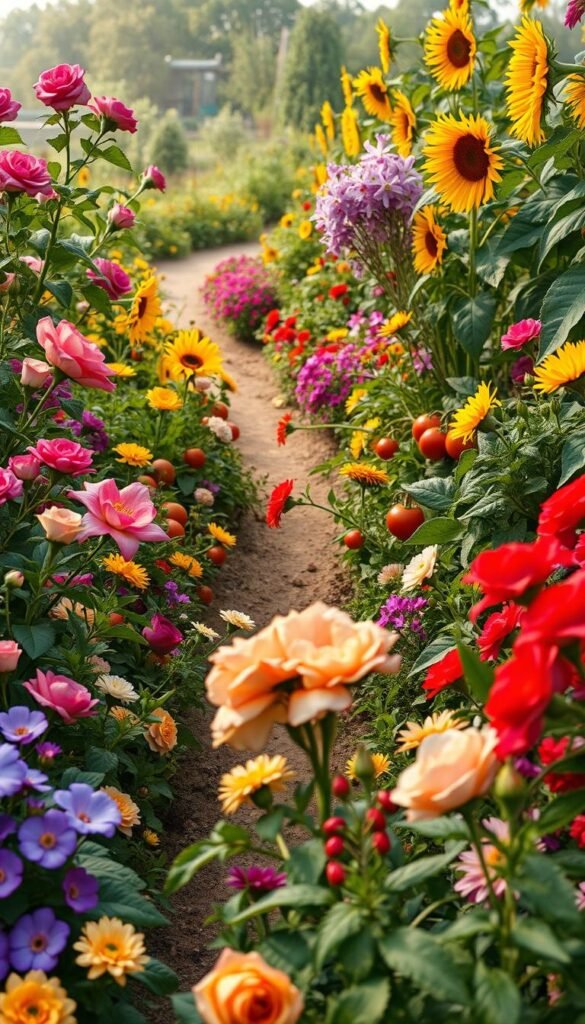Imagine stepping outside to a space where every plant serves multiple purposes. Vibrant petals sway beside plump tomatoes, while herbs whisper secrets to blooming neighbors. This isn’t just gardening—it’s crafting a living network where aesthetics meet practicality head-on.
By merging colorful blooms with edible crops, you create a self-reliant habitat. Marigolds shield tomatoes from pests, while basil enhances their flavor naturally. These partnerships reduce reliance on sprays, letting nature handle the heavy lifting. Discover how this method transforms your plot into a buzzing hub of life in our guide to strategic plant pairings.
Your green space becomes more productive while requiring less effort. Beneficial insects flock to nectar-rich flowers, pollinating veggies and controlling aphids simultaneously. The result? Healthier plants, bigger harvests, and fewer headaches.
This approach redefines what a thriving plot looks like. Instead of segregated rows, you’ll cultivate a tapestry of textures and tastes. It’s not just about growing food—it’s about nurturing an ecosystem that delights all your senses.
Introduction: Embracing a Dual-Purpose Garden
Your outdoor space holds untapped potential where beauty and productivity coexist. The French Potager tradition proves this balance isn’t new—it’s a centuries-old practice of blending edible crops with ornamental plants. This method turns plots into living puzzles where every piece supports the whole.
Understanding the Value of Companion Planting
Forget rigid rules. Successful pairings rely on simple principles: some vegetables deter pests, while others improve soil health. Tall sunflowers shield delicate greens from wind, and aromatic herbs confuse insects hunting for snacks. Nature’s teamwork does the heavy lifting.
Overview of Benefits and Aesthetic Appeal
Dual-purpose spaces deliver more than food. They offer cut blooms for vases, herbs for teas, and habitats for pollinators. Seasonal shifts bring fresh textures—spring radishes peek through pansies, while autumn pumpkins nestle beside chrysanthemums. It’s practicality wrapped in ever-changing beauty.
| Traditional Plot | Dual-Purpose Space | Key Advantage |
|---|---|---|
| Separate beds | Mixed plantings | Pest control |
| Single harvests | Multiple yields | Year-round use |
| Basic visuals | Layered textures | Visual depth |
This approach shrinks your workload while expanding rewards. You’ll spend less time battling aphids and more time enjoying bouquets fresh from your home garden. It’s gardening simplified through smart partnerships.
Key Principles Behind Combining Flowers and Vegetables
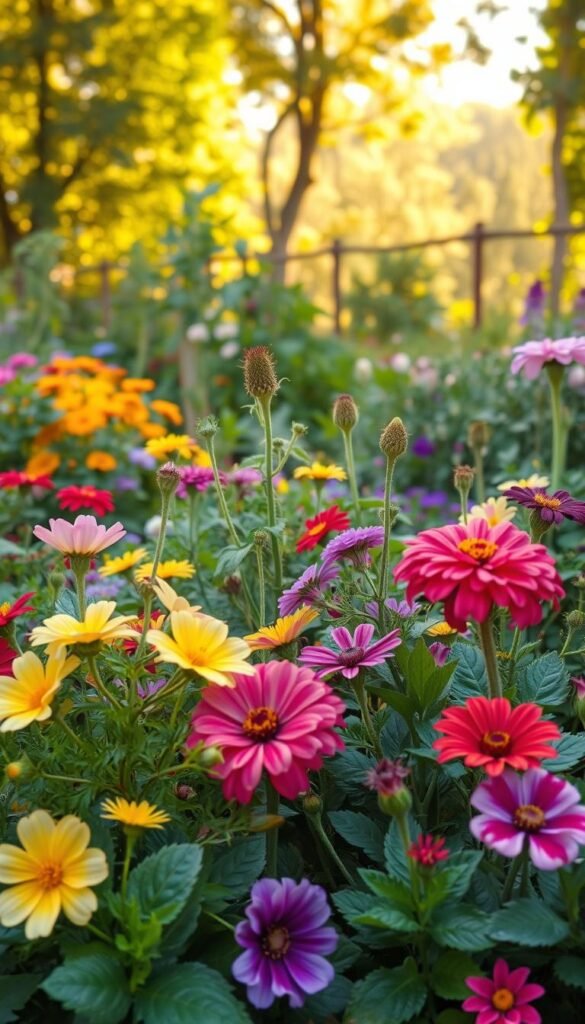
Nature thrives on collaboration, and your plot is no exception. Beneath the surface, roots exchange nutrients while leaves release scents that deter unwanted visitors. This hidden teamwork transforms your space into a resilient, self-supporting environment.
Nutrient Synergies and Pest Control
Plants chat through chemical signals you can’t see. Deep-rooted varieties like yarrow mine minerals from subsoil, sharing them with shallow-rooted neighbors. Meanwhile, pungent blooms like garlic chives mask your kale’s scent, tricking pests into flying elsewhere.
Trap crops become your secret weapon. Nasturtiums lure aphids away from beans, acting as sacrificial bodyguards. Research from companion planting strategies shows this method reduces chemical sprays by 60% in some trials.
Designing a Balanced Garden Ecosystem
Diversity is your soil’s best friend. Legumes fix nitrogen while daikon radishes break up compacted earth. This underground partnership creates a richer bed for all plants without extra fertilizers.
Beneficial insects need steady snacks. By staggering bloom times of herbs like dill and fennel, you’ll keep ladybugs patrolling for pest control all season. As noted in container garden studies, even small spaces can host these powerful partnerships.
Your plants become a team rather than competitors. Tall sunflowers provide shade for heat-sensitive lettuces, while sprawling squash leaves suppress weeds below tomatoes. It’s about creating connections where every element supports multiple functions.
Choosing the Right Flowers for Your Vegetable Patch
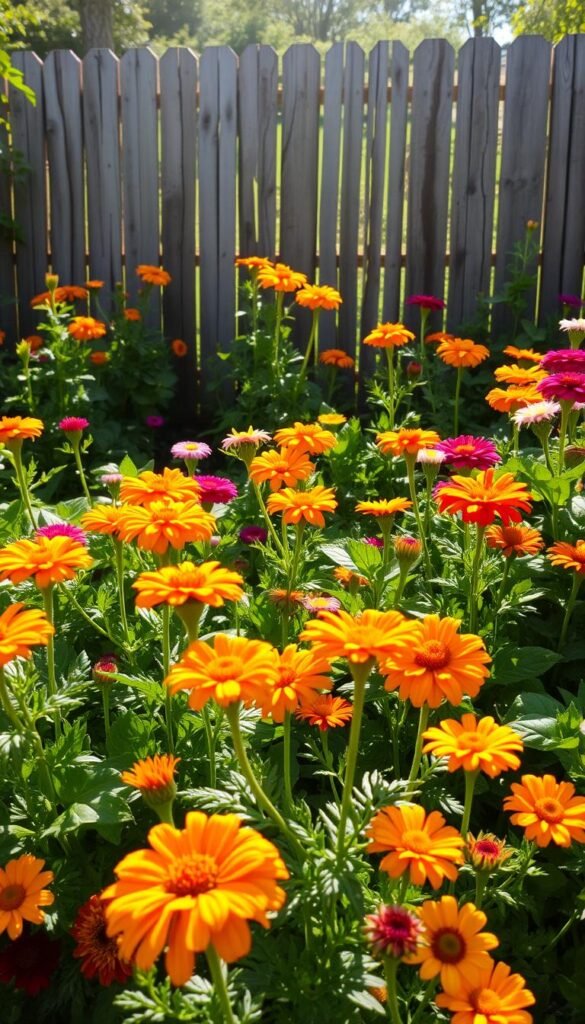
Three powerhouse blooms stand out when protecting your crops naturally. Calendula, marigold, and zinnia form a protective trifecta that works above and below ground to safeguard your harvests.
Nature’s Pest Control Squad
Calendula’s sunny petals act as insect magnets, drawing ladybugs that devour aphids. True marigold varieties release root chemicals that paralyze soil-dwelling nematodes. Zinnias’ bold colors confuse pests while attracting wasps that hunt tomato hornworms.
These plants create layered defenses. French marigolds mask your kale’s scent with their peppery aroma. Zinnias’ stiff stems deter cucumber beetles from landing, while calendula’s sticky leaves trap thrips.
Building Insect Alliances
Strategic bloom timing keeps beneficial insects patrolling all season. Early calendula flowers feed lacewings in spring. Summer zinnias sustain hoverflies, and autumn marigolds provide late nectar for parasitic wasps.
Mix tall zinnias with low-growing herbs to create pollinator pit stops. This living highway guides helpful bugs through your vegetable patch, boosting pollination rates naturally.
Best part? These flowers sprout easily from seeds. Scatter them between rows or plant as living mulch—they’ll reward you with pest control and vibrant color until frost.
Flower and Vegetable Garden Combined: Creative Companion Planting
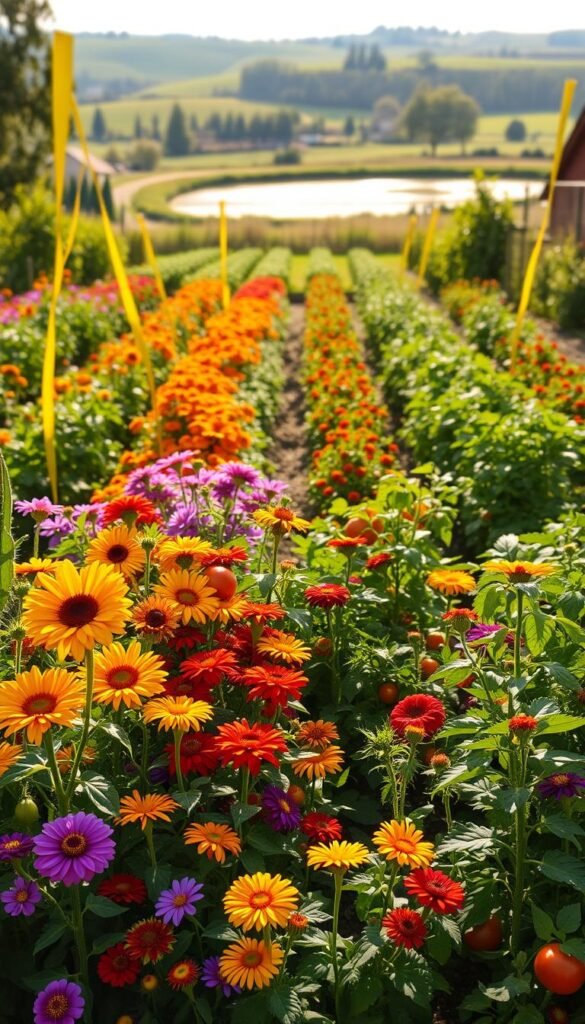
Beneath the soil’s surface, a hidden conversation unfolds through chemical signals and root networks. This silent teamwork determines which plants thrive together and which compete – knowledge that transforms how you design your space.
Exploring the Science of Beneficial Companions
Allelopathy reveals nature’s chemical chess game. Sunflowers release substances that suppress weed growth, while beans share nitrogen with corn through their roots. These interactions create living support systems without human intervention.
Timing matters as much as chemistry. Fast-growing radishes loosen soil for carrots arriving later. By harvest time, the radishes clear space just as carrot tops need room to expand. It’s like nature’s perfect handoff.
| Factor | Example | Benefit |
|---|---|---|
| Root Depth | Tomatoes + Basil | No nutrient competition |
| pH Needs | Blueberries + Azaleas | Shared acidic soil |
| Water Use | Lavender + Rosemary | Drought tolerance |
Microclimate management boosts success. Tall okra shields peppers from scorching sun, while mint’s spreading habit keeps soil moist for neighboring lettuce. Grouping plants with similar needs simplifies care and reduces guesswork.
Your watering routine adapts when thirsty cucumbers aren’t paired with drought-loving sage. Discover more seasonal companion planting strategies that align hydration needs naturally. These ways of working with nature’s patterns lead to healthier growth with less effort.
Top Listicle Tips for an Effective Companion Planting Garden
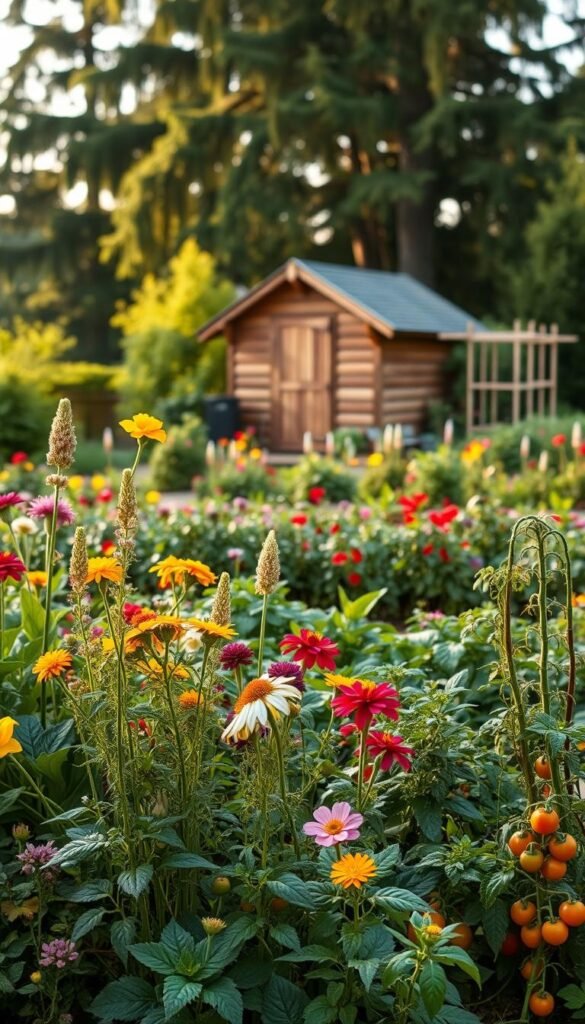
Transform your plot into a self-regulating sanctuary with these battle-tested strategies. Smart trap crops and precise seed timing turn your space into a living defense system that works while you sleep.
Strategic Pest Distraction Tactics
Nasturtiums become your garden’s secret agents. Plant these vibrant warriors near squash to lure squash bugs away from your harvest. Their peppery leaves act as irresistible bait, keeping your crops safe without chemicals.
Space deterrent plants like clockwork. Position marigolds every 4 feet between tomato rows to create an invisible pest barrier. This spacing confuses insects searching for their next meal.
Seed Mastery for Continuous Protection
Soil temperature dictates success. Cool-season allies like calendula sprout when ground reaches 55°F, while zinnias wait for 70°F warmth. Match sowing times to create overlapping pest patrols.
| Plant Type | Start Method | Ideal Temp |
|---|---|---|
| Marigolds | Direct sow | 70°F |
| Nasturtiums | Indoor start | 65°F |
| Sunflowers | Direct sow | 60°F |
Save seeds from heirloom varieties each fall. These genetic powerhouses adapt to your specific growing conditions year after year, strengthening your garden’s natural defenses.
Attracting Beneficial Insects and Pollinators
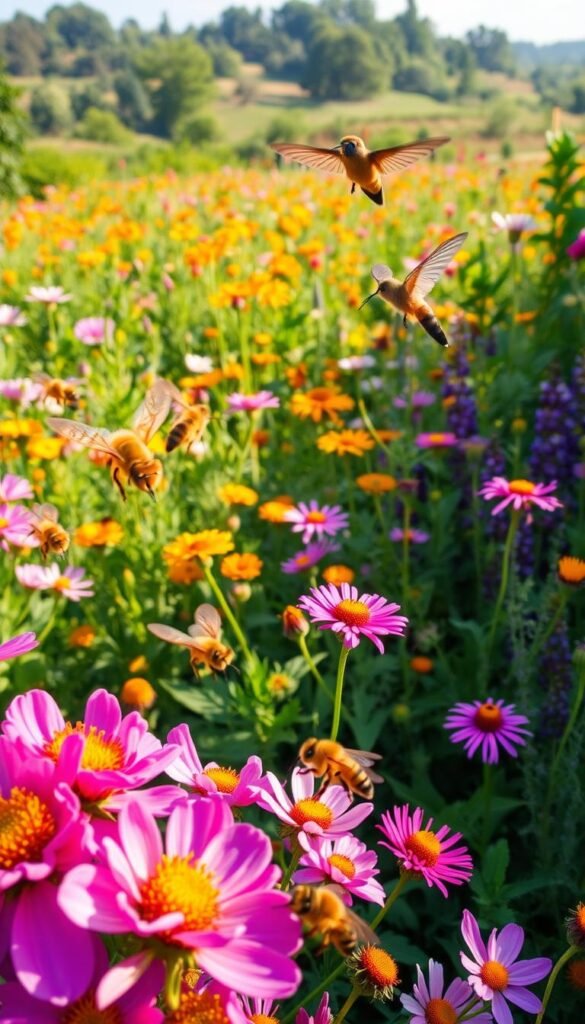
Your plot’s silent partners work overtime among blossoms and leaves. These tiny allies boost crop health while adding bursts of color and motion to your space. Strategic plant choices turn your beds into thriving ecosystems where pollinators and predators team up naturally.
Marigold and Chamomile: Pest Control Powerhouses
Chamomile’s fern-like leaves hide a secret weapon—their roots mine calcium from deep soil layers, enriching earth for neighboring crops. Meanwhile, marigolds release a chemical cocktail that repels root-eating bugs while luring hoverflies to devour aphids. Together, they form a living security system.
Bees flock to chamomile’s daisy-like blooms, while metallic green flies patrol marigold petals. This tag-team approach tackles pests above and below ground. You’ll spot fewer damaged leaves and more thriving veggies as these partnerships strengthen.
Crafting Year-Round Insect Havens
Diverse bloom shapes cater to different pollinators. Flat zinnia centers become landing pads for butterflies, while tubular lavender flowers feed thirsty hummingbirds. Stagger planting times so something’s always flowering—early crocuses wake sleepy bees, while autumn asters fuel migrating monarchs.
Leave some ground bare for solitary bees to nest, and stack rocks for ladybug hideouts. Chickadees will visit to snack on overwintering bugs, completing nature’s pest control cycle. Your space becomes a sanctuary where life thrives in every season.
| Plant | Key Attraction | Pest Targeted |
|---|---|---|
| Marigold | Hoverflies | Aphids |
| Chamomile | Parasitic wasps | Caterpillars |
| Lavender | Butterflies | Whiteflies |
Creative Layouts for a Bountiful Flower and Vegetable Garden
Your plot transforms into a living mosaic when you layer plants by height and hue. Strategic placement creates visual drama while optimizing every inch of space. Let’s explore how to design a layout that marries form and function effortlessly.
Maximizing Space with Thoughtful Design
Tall cosmos become natural backdrops, framing shorter crops like peppers and basil. These towering blooms reach 5-6 feet, casting dappled shade for heat-sensitive lettuces below. Meanwhile, compact zinnias add splashes of color between tomato plants without overcrowding.
Vertical layers work wonders in small plots. Train climbing beans up sunflower stalks, or let nasturtiums spill over raised bed edges. This approach turns unused air space into productive zones while keeping pathways clear.
| Plant Type | Height Range | Companion Role |
|---|---|---|
| Cosmos | 4-6 ft | Windbreak/Shade |
| Zinnias | 1-5 ft | Pest Deterrent |
| Bush Beans | 1-2 ft | Ground Cover |
Color coordination elevates your garden’s appeal. Pair purple basil with orange marigolds, or let red salvia pop against green bean vines. These combinations attract pollinators while making harvests feel like treasure hunts.
Rotate focal points seasonally—sunflowers command attention in summer, while ornamental kale steals the fall spotlight. This strategy maintains visual interest as crops mature, ensuring your space remains vibrant from spring frost to autumn’s first chill.
Addressing Challenges in a Mixed Garden Setting
Even the most harmonious gardens face occasional hiccups. When blooms and edibles share soil, you’ll need smart fixes for unexpected guests or thirsty roots. Start by observing patterns—yellow leaves might signal pH shifts, while chewed stems reveal pest hideouts.
Troubleshooting Pest Issues and Soil Imbalances
Borage works wonders near tomatoes, cutting hornworm damage by half. But stay vigilant—check undersides of leaves weekly. A quick hand-picking session beats chemical sprays any day.
Group thirsty squash away from drought-tolerant herbs. Deep-rooted varieties drink from subsoil reserves, while shallow-rooted greens need frequent sips. This separation prevents soggy roots and wasted water.
Summer’s heat amplifies soil pH swings. Test beds monthly, adding lime if acidity spikes. For natural aphid control, try garlic spray—it deters 89% of these sap-suckers without harming pollinators.
Remember: partnerships like those in strategic plant pairings strengthen your garden’s defenses. Adjust your approach as seasons shift, and your resilient ecosystem will thrive through every challenge.

